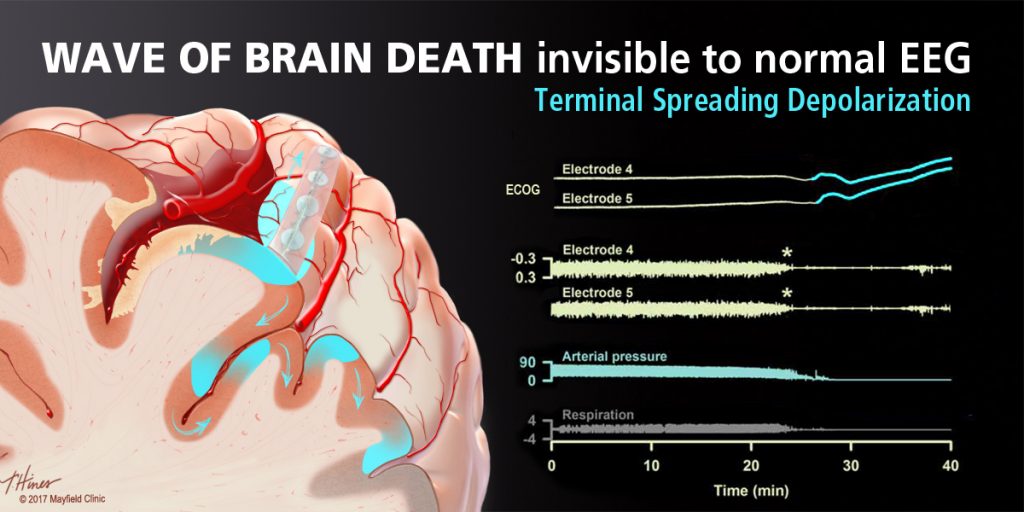
A new study furthers research on “brain tsunamis” and provides insight into the neurobiology of dying.
Researchers monitored a group of 9 patients who suffered devastating brain injuries caused by brain trauma or subarachnoid hemorrhage (bleeding after a brain aneurysm rupture). When the patients failed to respond to treatment in the intensive care unit, their families signed a Do Not Resuscitate (DNR) order and requested that their loved ones receive only comfort care.
Over the next moments, researchers studied the sequence of events in the brain and circulatory system, using advanced methods to measure brain pressure, oxygen levels, and electrical activity. They found that brain electrical function stopped near the time of systemic circulatory arrest, as expected. However, it would take more several minutes until the final brain wave developed, a tsunami-like wave called a spreading depolarization.

The wave of brain death: terminal spreading depolarization occurs several minutes after ECoG shows electrical silence (asterisks) and circulatory arrest and respiration have ended. Illustration by Tonya Hines © Mayfield Clinic.
“We know from animal studies that the toxic chemical and cellular changes that lead to brain death after circulatory arrest don’t begin for several minutes, well after brain activity has stopped,” says Jed Hartings, PhD, a lead author and Associate Professor in the Department of Neurosurgery at the University of Cincinnati. “These initiate spreading depolarizations, which begin the countdown to irreversible damage.”
Evidence of terminal spreading depolarization was seen in most of the patients. These waves were once thought to develop only in some neurologic diseases, such as migraine with auras. This new study suggests that everyone will experience a brain tsunami at the end of life.
Spreading depolarizations in the dying process have not been observed previously because they can’t be detected with normal clinical EEG methods. “If brain circulation can be restored quickly, the cellular changes of spreading depolarization may be reversible,” Dr. Hartings says. “Therefore, our findings have potential for protecting the brain after survivable ischemic insults, such as stroke and cardiac arrest.”
Prof. Jens Dreier, at the Center for Stroke Research Berlin, explains, “Our findings may also help fine-tune strategies for organ donation protocols. Death is typically declared between 2 and 10 minutes after circulatory arrest. But until the final tsunami-like wave occurs, the brain cells remain quite viable.”
The team’s findings were published online last week in the journal Annals of Neurology.
News coverage of the article has been brisk and can be followed on Altmetric.
Additional authors include: Sebastian Major, MD, Maren Winkler, MD, Eun-Jeung Kang, MD, Denny Milakara, MD, Coline Lemale, MD, Johannes Woitzik, MD, and Jason M. Hinzman, PhD of Charité – Universitätsmedizin Berlin; Brandon Foreman, MD, University of Cincinnati; Vince DiNapoli, MD, PhD, and Norberto Andaluz, MD, of Mayfield Clinic; and Andrew Carlson, MD of the University of New Mexico.
The field of study in spreading depolarizations is growing as researchers and clinicians collaborate and share their insights to improve patient monitoring and treatment. The iCSD 2018 meeting will be held September 22-24 in Boca Raton, Florida, USA in conjunction with the annual meeting of the Neurocritical Care Society.

— Mary Kemper
